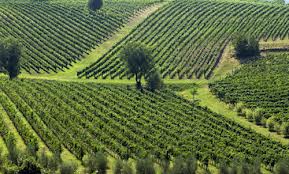Basilicata may have almost as many vineyards as the famous northern wine region of Trentino-South Tyrol, but unfortunately in terms of quality Basilicata only accounts for around ten per cent of its DOC production. Basilicata is a decidedly mountainous region, which goes down to sea level in the southeast and is probably one of Italy's poorest regions. In terms of quality wine, Basilicata only has one mark of origin, the great red Aglianico del Vulture, the rest of its wine production is sold as annonymous bulk wines which is mostly used to bulk out other more reputable table wines of the more northern regions of the Italian peninsula.
On the slopes of the extinct volcano Monte Vulture to the north of Basilicata, the famous Aglianico grapes grow at around 1500 to 2000 feet (450-600 Metres). It is believed that Aglianico was bought here by the ancient Greeks - Aglianico is only a derivation of ellenico, the Italian word for Greek - and form the basis of probably the most well-known and most important DOC wine of southern Italy. Basilicata Aglianico wines, when treated with good viticultural techniques and careful cellaring, are deep dark in colour with a powerful fruit bouquet and good full body, Aglianico when made well can be stored and aged in oak for long periods of time and benefit from this treatment, unlike many other Italian wines.
The unusual features of the landscape around the towns of Barile and Rionero are the earth cellars that have been dug into the soft loessial cliffs around the river valley's. Another strange feature is the local custom to grow the vines on pyramidal poles, which even today many local wine growers believe to be the best method of producing high quality Aglianico wines. Aglianico plays a major role in the wine regions of Campania and Apulia, producing the famous wines of Taurasi and Castel del Monte.


No comments:
Post a Comment